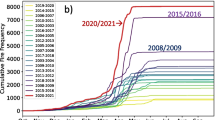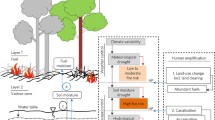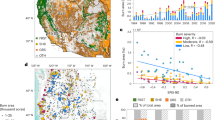Abstract
Wildfire is increasingly a concern in the USA, where 10 million acres burned in 2015. Climate is a primary driver of wildfire, and understanding fire-climate relationships is crucial for informing fire management and modeling the effects of climate change on fire. In the southwestern USA, fire-climate relationships have been informed by tree-ring data that extend centuries prior to the onset of fire exclusion in the late 1800s. Variability in cool-season precipitation has been linked to fire occurrence, but the effects of the summer North American monsoon on fire are less understood, as are the effects of climate on fire seasonality. We use a new set of reconstructions for cool-season (October–April) and monsoon-season (July–August) moisture conditions along with a large new fire scar dataset to examine relationships between multi-seasonal climate variability, fire extent, and fire seasonality in the Jemez Mountains, New Mexico (1599–1899 CE). Results suggest that large fires burning in all seasons are strongly influenced by the current year cool-season moisture, but fires burning mid-summer to fall are also influenced by monsoon moisture. Wet conditions several years prior to the fire year during the cool season, and to a lesser extent during the monsoon season, are also important for spring through late-summer fires. Persistent cool-season drought longer than 3 years may inhibit fires due to the lack of moisture to replenish surface fuels. This suggests that fuels may become increasingly limiting for fire occurrence in semi-arid regions that are projected to become drier with climate change.





Similar content being viewed by others
References
Cook BI, Seager R (2013) The response of the North American monsoon to increased greenhouse gas forcing. J Geophys Res 118:1690–1699. doi:10.1002/jgrd.50111
Crimmins MA, Comrie AC (2004) Interactions between antecedent climate and wildfire variability across south-eastern Arizona. Int J Wildl Fire 13:455–466
Dennison PE, Brewer SC, Arnold JD, Moritz MA (2014) Large wildfire trends in the western United States, 1984–2011. Geophys Res Lett 41:2928–2933. doi:10.1002/2014GL061184
Farris CA, Baisan CH, Falk DA et al (2010) Spatial and temporal corroboration of a fire-scar-based fire history in a frequently burned ponderosa pine forest. Ecol Appl 20:1598–1614
Fitch EP, Meyer GA (2016) Temporal and spatial climatic controls on Holocene fire-related erosion and sedimentation, Jemez Mountains, New Mexico. Quat Res 85:75–86. doi:10.1016/j.yqres.2015.11.008
Fulé PZ, Covington WW, Moore MM (1997) Determining reference conditions for ecosystem management of southwestern ponderosa pine forests. Ecol Appl 7:895–908
Gochis D, Schemm J, Shi W et al (2009) A forum for evaluating forecasts of the North American monsoon. Eos (Washington DC) 90:249–250. doi:10.1130/GES00147.1.Oberlies
Griffin D, Meko DM, Touchan R et al (2011) Latewood chronology development for summer-moisture reconstruction in the US southwest. Tree-Ring Res 67:87–101
Griffin D, Woodhouse CA, Meko DM et al (2013) North American monsoon precipitation reconstructed from tree-ring latewood. Geophys Res Lett 40:954–958
Grissino-Mayer HD, Swetnam TW (2000) Century-scale climate forcing of fire regimes in the American southwest. The Holocene 10:213–220
Keeley JE, Syphard AD (2016) Climate change and future fire regimes: examples from California. Geosciences 6:1–14. doi:10.3390/geosciences6030037
Kitzberger T, Brown PM, Heyerdahl EK et al (2007) Contingent Pacific-Atlantic Ocean influence on multicentury wildfire synchrony over western North America. Proc Natl Acad Sci U S A 104:543–548
Krawchuk MA, Moritz MA, Parisien MA et al (2009) Global pyrogeography: the current and future distribution of wildfire. PLoS One 4:e5102. doi:10.1371/journal.pone.0005102
Littell JS, McKenzie D, Peterson DL, Westerling AL (2009) Climate and wildfire area burned in western U. S. ecoprovinces, 1916-2003. Ecol Appl 19:1003–1021
Littell JS, Peterson DL, Riley KL et al (2016) A review of the relationships between drought and forest fire in the United States. Glob Chang Biol 22:2353–2369. doi:10.1111/gcb.13275
Maguire WP (1956) Are ponderosa pine crops predictable? J For 54:778–779
Malevich SB, Margolis EQ, Guiterman CH (2015) Burnr: fire history analysis in R. https://github.com/ltrr-arizona-edu/burnr
Margolis EQ, Swetnam TW (2013) Historical fire-climate relationships of upper elevation fire regimes in the south-western United States. Int J Wildl Fire 22:588–598
Marlon JR, Bartlein PJ, Gavin DG et al (2012) Long-term perspective on wildfires in the western USA. Proc Natl Acad Sci U S A 109:E535–E543
Moritz MA, Parisien M-A, Batllori E et al (2012) Climate change and disruptions to global fire activity. Ecosphere 3:art49. doi:10.1890/ES11-00345.1
R Core Team (2015) R: A language and environment for statistical computing. Version 3.1.1
Seager R, Vecchi GA (2010) Greenhouse warming and the 21st century hydroclimate of southwestern North America. Proc Natl Acad Sci 107:21277–21282. doi:10.1073/pnas.0910856107
Seager R, Ting MF, Held I et al (2007) Model projections of an imminent transition to a more arid climate in southwestern North America. Science 316:1181–1184
Stephens SL, Burrows N, Buyantuyev A et al (2014) Temperate and boreal forest mega-fires: characteristics and challenges. Front Ecol Environ 12:115–122. doi:10.1890/120332
Swetnam TW (1993) Fire history and climate change in giant sequoia groves. Science 262:885–889
Swetnam TW, Betancourt JL (1990) Fire-southern oscillation relations in the southwestern United States. Science 249:1017–1020
Swetnam TW, Betancourt JL (1998) Mesoscale disturbance and ecological response to decadal climatic variability in the American southwest. J Clim 11:3128–3147
Swetnam TW, Farella J, Roos CI et al (2016) Multi-scale perspectives of fire, climate and humans in western North America and the Jemez Mountains, USA. Proc R Soc London Ser B-Biological Sci 371:20150168. doi:10.1098/rstb.2015.0168
Touchan R, Allen CD, Swetnam TW (1996) Fire history and climatic patterns in ponderosa pine and mixed-conifer forests of the Jemez Mountains, northern New Mexico. USDA For. Serv. RM-GTR-286:33–46
Westerling AL (2016) Increasing western US forest wildfire activity: sensitivity to changes in the timing of spring. Philos Trans R Soc London Ser B 371:20150178. doi:10.1098/rstb.2015.0178
Westerling AL, Gershunov A, Brown TJ et al (2003) Climate and wildfire in the western United States. Bull Am Meteorol Soc 84:595–604
Westerling AL, Hidalgo HG, Cayan DR, Swetnam TW (2006) Warming and earlier spring increase western US forest wildfire activity. Science 313:940–943
Williams A, Allen CD, Macalady AK et al (2013) Temperature as a potent driver of regional forest drought stress and tree mortality. Nat Clim Chang 3:292–297
Williams AP, Seager R, Macalady AK et al (2015) Correlations between components of the water balance and burned area reveal new insights for predicting forest fire area in the southwest United States. Int J Wildl Fire 24:14–26
Acknowledgements
This work was supported by the National Science Foundation Macrosystems award number 1065790. K. Miller, B. Olimpio, L.B. Johnson, C.H. Guiterman, E. Bigio, D.A. Falk, C.H. Baisan, and S.B. Malevich provided comments and assistance with data collection and data management. G. Meyer and two anonymous reviewers provided useful comments. We thank the researchers who developed the fire history data used in this study, particularly D.A. Falk, C.H. Baisan, and C.D. Allen. This work is a contribution of the Western Mountain Initiative, a USGS global change research project. Any use of trade, firm, or product names is for descriptive purposes only and does not imply endorsement by the US Government.
Author information
Authors and Affiliations
Corresponding author
Electronic supplementary material
ESM 1
(DOCX 344 kb)
Rights and permissions
About this article
Cite this article
Margolis, E.Q., Woodhouse, C.A. & Swetnam, T.W. Drought, multi-seasonal climate, and wildfire in northern New Mexico. Climatic Change 142, 433–446 (2017). https://doi.org/10.1007/s10584-017-1958-4
Received:
Accepted:
Published:
Issue Date:
DOI: https://doi.org/10.1007/s10584-017-1958-4




